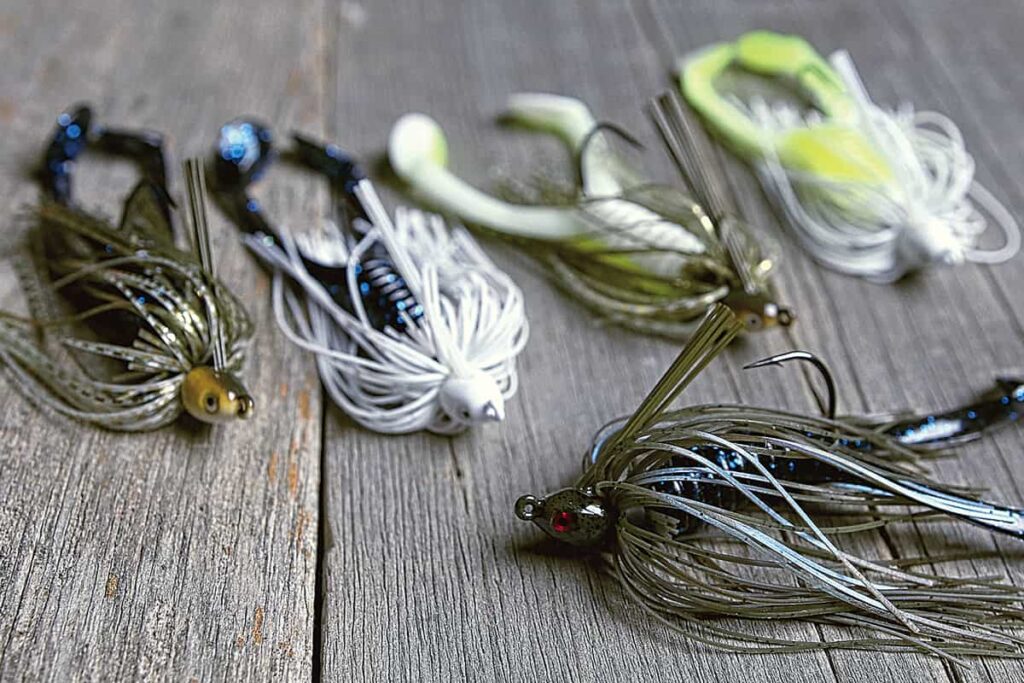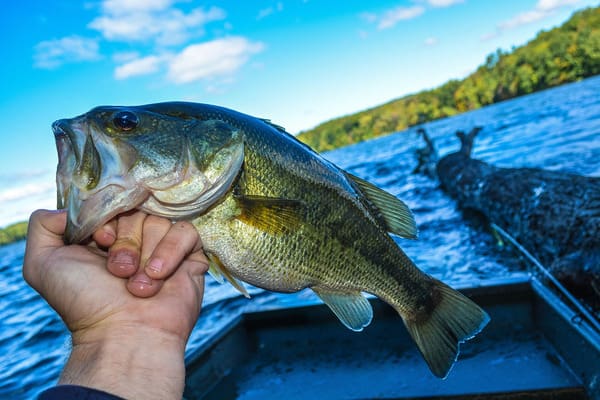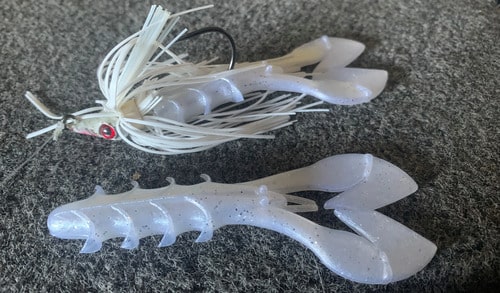How to Fish a Swim Jig for Bass

Mastering the art of how to fish a swim jig unlocks a realm of versatility and effectiveness in bass angling.
Understanding when and where to employ this lure, along with fine-tuning your retrieval techniques and gear setup, can significantly enhance your chances of landing that elusive trophy bass.
When to Use a Swim Jig?

Swim jigs are so versatile that you can really fish them anytime of year, day, or weather and have success.
But swim jigs do have certain times where they really shine.
Post Spawn
Post spawn bass love shallow cover. They will hold very tightly to grass, wood, and up under overhanging brush.
These bass are feeding on bluegill, frogs, and other forage that live in and around this cover.
A swim jig is the perfect lure to cover water in a subtle way, without getting hung up and snagged.
Post spawn bass have just finished a very tiresome spawn, so they are looking for easy, subtle meals.
You don’t want a loud or super aggressive lure, because the bass don’t have the energy to attack those lures during the post spawn.
The swim jig is one of the all time best post spawn bass lures.
Summer
With the hot summer comes tons of thick vegetation. Bass will sit right in this vegetation and wait for a bluegill or other prey to helplessly swim by.
Then, the bass will ambush. When fishing heavy grass in warm water, my two favorite lures are a swim jig and a hollow body frog.
The swim jig can outperform a frog because it is much more versatile. You can fish it in every water column.
You can even flip it into a piece of isolated cover and hop it around.
Swim jigs are fantastic summer lures for bass that are up in shallow cover hiding from the sun.
Calm Days (low wind)
You want to use swim jigs on calm days when there isn’t a lot of wind or chop on the water.
When the water is real choppy, lures like spinnerbaits or crankbaits work better.
The choppy water tosses around the light and disorients the bass a little bit.
Lures with more flash and vibration will work much better on windy days.
Where to Fish a Swim Jig?

Obviously, the first place is to just fish a swim jig around cover.
The weedless aspect of the jig is what makes it such a special moving bait.
But I am sure you already new that, so let’s get into some other places.
Shallow Water
To me, the swim jig is strictly a shallow water lure. I almost never use one when fishing more than 8 feet of water.
One reason for this is that swim jigs are fairly subtle baits. They don’t have flashy blades, loud rattles, or tons of vibration.
So the deeper the water is, the harder it will be for bass to hone in on them.
Another reasons is, again, the cover. Shallow cover like grass and wood is where a swim jig shines.
Out in deeper water, you don’t tend to have as many laydowns or vegetation, so other baits like a spinnerbait or crankbait will work better.
Of course there are exceptions the the rule, but the swim jig really is made to be fished in shallow water.
Stained Water
Now don’t get me wrong, a swim jig will work in crystal clear water, and also in very muddy, dark water.
But it really shines when the water is stained. Anywhere from 1.5-4 feet of water visibility seems to be the best range.
The main reasons for this is that a swim jig is both subtle and not hyper realistic.
It doesn’t have enough sound or vibration to attract bass in very muddy water.
And it isn’t quite realistic enough to outperform other lures in clear water. But swim jigs work extremely well in stained water.
Also Read: Best Swim Jig Weight
Retrieval: How to Work a Swim Jig
Because of a swim jig’s versatility, you can kind of work it however you want.
It allows anglers to let the bass dictate how to retrieve the lure based on their mood.
With that being said, I only ever use two retrieval methods when working a swim jig.
Steady Reel
Just cast and reel it back in. This makes the swim jigs pretty much a bladeless spinnerbait or a skirted swimbait.
This is a very subtle presentation, but you still have the bigger profile of a jig paired with complete weedlessness.
A steady reel retreive works really well in very shallow water or when bringing the bait through reeds, lily pads, and other stalk like vegetation.
Hopping Retrieve
This is my personal preference the majority of the time. Rather than simply reeling the bait in, you are bouncing it up and down with your rod tip while reeling in the slack.
Almost like you are walking the dog, but you are popping your rod tip up rather than to the side.
This method gives the swim jig an awesome up and down motion as it swims through the water.
It also allows you to fish the bait much slower than if you were simply reeling it straight in.
This is how I fish my swim jigs 75% of the time, and it works like crazy.
Swim Jig Trailers
There are two styles of trailers that you can use on a swim jig. Those are paddle tail baits and craw style baits.
Paddle Tail Trailers

Paddle tail trailers are good for a couple situations. Firstly, they are a bit more natural of a baitfish imitation.
These trailers are great if you are imitating baitfish like bluegill or shad in a bit clearer water.
Paddle trailers are also better for fishing the jig in very thick grass or brush.
The slender and compact shape allows the jig to glide through the cover much easier.
Craw Trailers

I tend to prefer craw style trailer better. Craw trailers give a more compact and thick presentation that I love.
Also, if you are using the hopping retrieve, craw trailers will work much better.
Their flat shape and wide, flapping claws will glide the jig through the water with every hop.
So you can hop the swim jig very slowly and precisely along. I also feel like craw trailers are a bit more versatile.
You can still reel them in and get the flapping action from the claws.
You can also fish the bait towards the bottom or flip it to cover and imitate crawfish very well. For these reasons, I prefer craw trailers most of the time.
Choosing Swim Jig Colors
Do not overcomplicate your color choices. You only ever need three colors when fishing a swim jig.
- Bluegill pattern: A natural bluegill pattern or a green pumpkin will be ideal for imitating panfish or crawfish.
- Black or Black/Blue: If you are fishing real muddy water and still want to use a swim jig, use a black one so that bass can locate and eat the jig.
- White: Obviously, white is going to be your shad imitation. Especially during the late summer and early fall months, white can be a great option.
Also Read: 5 Best Swim Jigs
Swim Jig Modifications
Trimming the Weed Guard
I almost always trim up the weed guards on my swim jigs. The main reason to do this is that it increases hook up ratios.
When the weed guard is shorter and cut at an angle, it is much easier for the bass to push it out of the way and expose the hook.
If you are fishing very heavy cover, it is probably best not to trim the weed guards because it can result in some snags.
But otherwise, this will drastically increase your hook up ratio and put more bass in the boat.
Trimming the Skirt
This is a pretty standard modification for all skirted baits. Trimming up the skirt does two things.
First, when the skirt is shorter, the hook is closer to the back of the lure.
This means when bass bite the swim jig, they are more likely to get the hook in their mouth and not short strike the bait.
The other thing that it does it causes the skirt to flair out a bit and give the swim jig a bigger profile.
And bigger profiles get bigger bites. I would recommend to trim the skirt until it hangs about 1/4 inch below the end of the hook.
This keeps the hook hidden while giving you the above benefits.
Gear for Swim Jig Fishing
Reeling this In
In the dynamic world of bass fishing, the swim jig stands out as a reliable and adaptable tool in the angler’s arsenal.
By recognizing its ideal conditions for use, from post-spawn to summer vegetation and calm waters, and honing your retrieval methods and bait modifications, you can elevate your fishing game to new heights.
So next time you hit the water, don’t overlook the potential of the swim jig to entice those elusive bass lurking beneath the surface.






